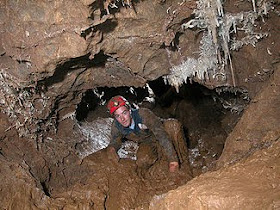Caving—also known as spelunking by some in the United States and occasionally potholing in the United Kingdom—is the recreational pastime of exploring wild (generally non-commercial) cave systems. In contrast, speleology is the scientific study of caves and the cave environment.
The challenges of the activity depend on the cave being visited, but often include the negotiation of pitches, squeezes, and water (though actual cave diving is a separate sub-specialty undertaken only by very few cavers). Climbing or crawling is often necessary, and ropes are used extensively for safety of the negotiation of particularly steep or slippery passages.
Caving is often undertaken for the enjoyment of the outdoor activity or for physical exercise, as well as original exploration, similar to mountaineering or diving. Physical or biological science is also an important goal for some cavers. Virgin cave systems comprise some of the last unexplored regions on Earth and much effort is put into trying to locate and enter them. In well-explored regions (such as most first-world countries), the most accessible caves have already been explored, and gaining access to new caves often requires digging or diving.
Caves have been explored out of necessity (for shelter from the elements or from enemies), out of curiosity or for mystical reasons for thousands of years. However, only in the last century or two has the activity developed into a sophisticated, athletic pastime. In recent decades caving has changed considerably due to the availability of modern protective wear and equipment. It has recently come to be known as an "extreme sport" by some (though not commonly considered as such by its practitioners, who may dislike the term for its perceived connotation of disregard for safety).
Many of the skills of caving can also be used in the nature activities of mine exploration and urban exploratio

No comments:
Post a Comment